

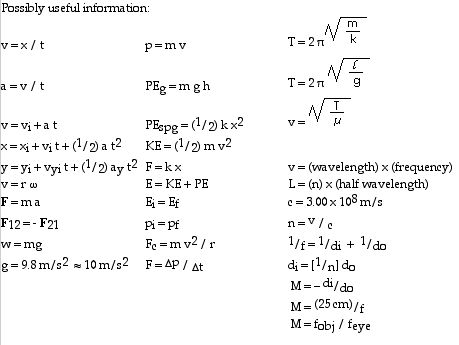
![]()
For every question, also consider as a possible answer
E) none of the above
1. Light
A) is a longitudinal wave. Light is a transverse
wave; sound is a longitudinal wave.
B) can be produced by accelerating an electric charge along a wire (or antenna).
Much longer wavelength EM radiation.
C) has a wavelength between 200 nm and 400 nm. Light has
a wavelength between 400 nm (for violet)
and 700 nm (for red).
D) all of the above
E) none of
the above
2. Light
A) is an electromagnetic wave.
B) is a longitudinal wave.
C) has a wavelength between 800 nm and 900 nm. Light has
a wavelength between 400 nm (for violet)
and 700 nm (for red).
D) all of the above
3. Light
A) was too slow for Galileo to measure.
B) was considered a wave by Newton.
C) was considered a stream of particles by Huygens.
D) all of the above
E) none of
the above
4. The speed of light
A) was too slow for Galileo to measure.
B) was measured by Ole Romer using astronomical data.
C) was measured by A A Michelson using the photoelectric effect.
D) all of the above
5. The speed of light was measred by
A) Galileo in Pisa.
B) Sir Isaac Newton at Cambridge University.
C) AA Michelson at the US Naval Academy.
D) Albert Einstein at the Center for Advanced Study.
6. Compared to infrared waves, the wavelength of
ultraviolet is
A) longer
B) identical
C) shorter

7. Compared to radio waves, the velocity
of visible light waves in a vacuum is
A) greater
B) the same
C) less
8. Compared to radio waves, the wavelength
of visible light waves in a vacuum is
A) longer
B) the same
C) shorter

9. Electromagnetic waves consist of
A) compressions and rarefactions of electromagnetic pulses.
B) oscillating electric and magnetic fields.
C) particles of light energy.
D) high-frequency gravitational waves.
10. Sound waves
A) can travel through a vacuum.
B) need a medium to travel through.
11. The main difference between a radio wave and a light wave is its
A) speed; They are both EM waves so they have the same
speed.
B) wavelength
C) EM characteristic; They are both EM waves.
D) all of the above
12. Which of these electromagnetic waves has the longest wavelength?
A) gamma rays
B) visible light
C) infrared radiation
D) radio waves

13. The sensation of color
is seen when light falls on the eye's
A) rods
B) cones
C) cornea
D) ciliary lens
14. A spotlight produces white light which then passes through a filter that
absorbs the green light. What color
is the light that passes through?
A) red
B) magenta
C) cyan
D) yellow
15. When you see a rainbow, you see
A) red on the inside and violet on the outside
B) yellow on the outside and green on the inside
C) yellow on the inside and green on the outside
D) violet on the inside
and red on the outside
16. The colored dots that make up the color on a TV screen are
A) red, yellow, green
B) red, yellow, blue
C) red, green, blue
D) cyan, magenta, yellow
17. Colors seen on TV result from color
A) subtraction
B) addition
C) neither of these
D) either of these
18. Colors produced by an ink-jet printer result from color
A) subtraction
B) addition
C) neither of these
D) either of these
19. Look at a full-color picture in a magazine with a magnifying glass and you
will see that the inks used are
A) red, green, cyan, and blue.
B) red, green, blue, and black.
C) Cyan, Magenta,
Yellow, and blacK.
Sometimes referred to as a CYMK process
D) cyan, green, yellow, and blue.
20. A mixture of red and blue
light produces
A) blue
B) magenta
C) yellow
D) cyan
21. A sheet of green paper will look black
when illuminated with
A) red light
B) cyan light; Cyan contains green and blue.
C) yellow light; Yellow contains green and red.
D) white light; White light contains all colors.
22. As light passes from glass into air, it is bent
A) toward the perpendicular
B) away from the perpendicular
23. Refraction causes the bottom of a swimming pool to appear
A) farther away than it really is
B) closer to the surface than it really is

24. Different colors are dispersed by a prism because different colors in the
spectrum have different
A) angular momenta
B) speeds
C) energies
D) momenta
25. The critical angle for a transparent material is the angle
at and beyond which all light within the material is totally
A) absorbed
B) reflected; remember "total internal reflection"?
C) refracted
D) polarized
26. Light will not pass through a pair of Polaroid filters when their axes are
A) parallel
B) rotated 45°
C) perpendicular
27. Consider two Polaroid filters, A and B, rotated 90° with respect to
each other as sketched here:
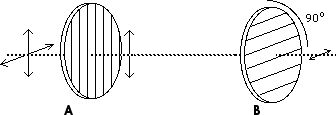
Now place another Polaroid filter C, between these two, as sketched here:
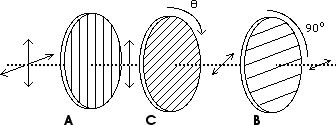
As Polaroid filter C is rotated through a full 360°, the light coming through
this combination of filters goes from bright to dark how many times?
A) none; it remains dark.
B) two times.
C) four times
D) eight times
28. Your vision is sharpest when your pupil is
a) dilated or opened wide
b) constricted or made tiny; Remember a pin-hole
camera.
c) blue
d) brown
29. Rainbows are a result of
A) dispersion and reflection.
B) dispersion and polarization.
C) reconstruction and polarization.
D) constructive and destructive interference.
30. A single rainbow requires
A) only one reflection inside the raindrops.
B) two reflections inside the raindrops.
C) constructive interference inside the raindrops.
D) destructive interference inside the raindrops.
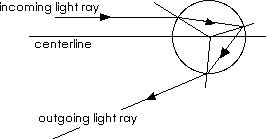
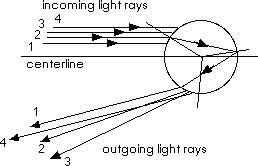
31. A double rainbow is a result of
A) one refraction and two reflections.
B) one dispersion and two polarizations.
C) two reconstructions and one polarization.
D) two refractions and two reflections.
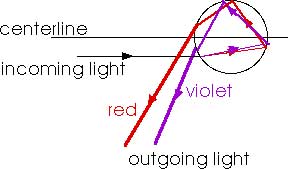
32. A 2-m tall person viewing his full-length image in a plane mirror requires
a mirror that is at least
A) 0.25 m
B) 0.50 m
C) 1.0 m
D) 2.0 m
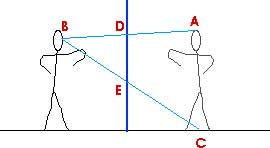
33. An object is placed 60 cm from a converging lens that has a focal length
of 20 cm. Make a ray diagram of this situation. From the ray diagram,
characterize the image.


The image is
A) real, inverted, and larger.
B) real, inverted, and smaller.
C) virtual, upright, and smaller.
D) virtual, inverted, and smaller.
34. An object is placed 40 cm from a converging lens that has a focal length
of 20 cm. Make a ray diagram of this situation. From the ray diagram, characterize
the image.
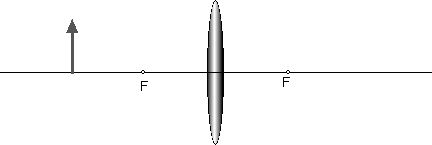

The image is
A) real and inverted (and the same size)
B) virtual, inverted, and smaller.
C) virtual, upright, and smaller.
D) virtual, inverted, and larger.
35. An object is placed 30 cm from a converging lens that has a focal length
of 20 cm. Make a ray diagram of this situation. From the ray diagram, characterize
the image.

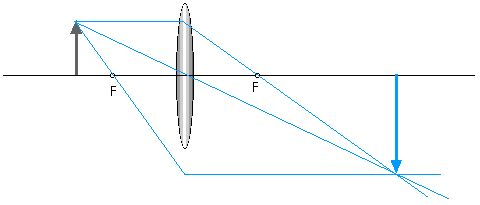
The image is
A) real, inverted, and larger.
B) real, inverted, and smaller.
C) real, upright, and smaller.
D) virtual, upright, and larger.
36. An object is placed 10 cm from a converging lens that has a focal length
of 20 cm. Make a ray diagram of this situation. From the ray diagram, characterize
the image.

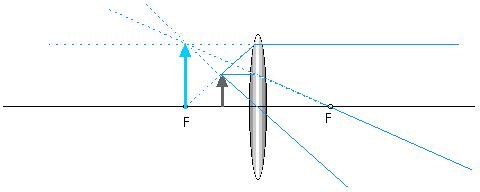
The image is
A) real, inverted, and larger.
B) real, inverted, and smaller.
C) virtual, upright, and smaller.
D) virtual, upright, and larger.
37. The “far point” of a person’s eye is
A) 25 cm
B) the farthest distance at which that person can clearly see an object
C) the nearest distance at which that person can clearly see an object
D) infinitly far away
38. The type of lenses needed to correct nearsighted vision is
A) converging
B) diverging
C) convex
D) concave
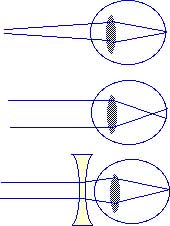
39. The type of lenses needed to correct farsighted vision is
A) converging
B) diverging
C) convex
D) concave
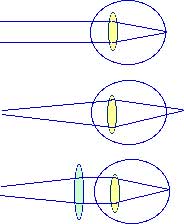
40. Initially, a camera is focused on some far-distant mountains. It is then
adjusted to focus on a nearby person . To do this, the lens
A) is moved closer to the film.
B) is moved farther from the film. Look
at the ray diagrams for questions 33 and 34.
C) is "opened" to larger aperature or larger opening.
D) is "shut down" to a smaller aperature or smaller opening.
41. A simple magnifier produces
A) a virtual image between the lens and your eye
B) a real image between the lens and your eye
C) a virtual image beyond the near point of your eye
D) a real image at infinity
42. In an optical system with two lenses, the image produced by the first lens
A) is alway inverted.
B) is always real
C) is always virtual
D) can be treated as an object for the second lens
43. A microscope uses the front lens or objective lens to produce a
A) virtual image which is right side up.
B) virtual image at infinity.
C) real image which is then viewed through the eyepiece.
D) real image which is right side up.
44. A telescope uses the front lens or objective lens to produce a
A) virtual image which is right side up.
B) virtual image at infinity.
C) real image which is then viewed through the eyepiece.
D) real image which is right side up.
45. A telescope that uses lenses is subject to
A) chromatic abberration. Image problems due to
dispersion.
B) spherical abberration.
C) aspherical abberration.
D) birefringence.
46. A Newtonian telescope is a
A) refracting telescope.
B) polarizing telescope.
C) reflecting telescope.
D) diffracting telescope.
47. We see interference effects if a laser is shined at or through a double
slit (this is Young’s double slit experiment). We do not see interference
effects due to the light coming from two flashlights because their light is
A) coherent.
B) incoherent.
C) too dim.
D) too bright.
48. Laser light passes through a single slit of width D andproduces an interference
pattern on a distant screen. As the slit width D increases, the interference
pattern
A) spreads out or gets larger
B) remains the same
C) shrinks or is compressed.
49. In the interference pattern produced by shining a laser through two slits
(Young's double slit experiment), the bright areas are the result of
A) destructive interference.
B) polarization.
C) constructive interference.
D) restructive construction.
50. When you view a white light source through a diffraction grating you will
see a brightly colored spectrum with
A) yellow on the outside and green on the inside
B) yellow on the inside and green on the outside
C) violet on the inside and red on the outside
D) red on the inside and violet on the outside
![]()